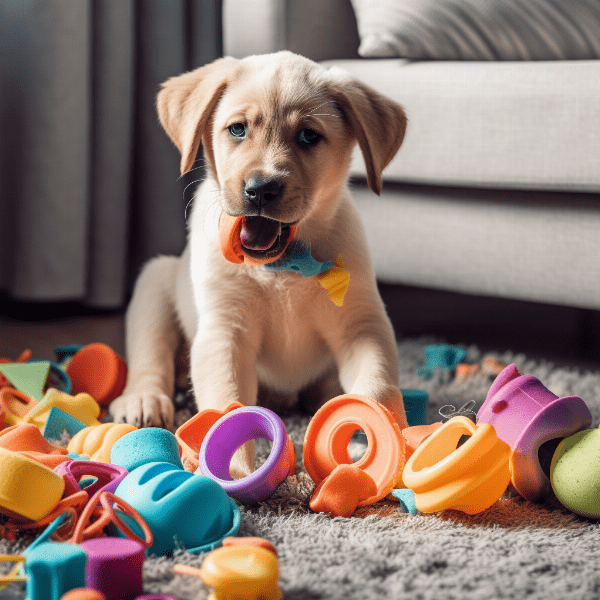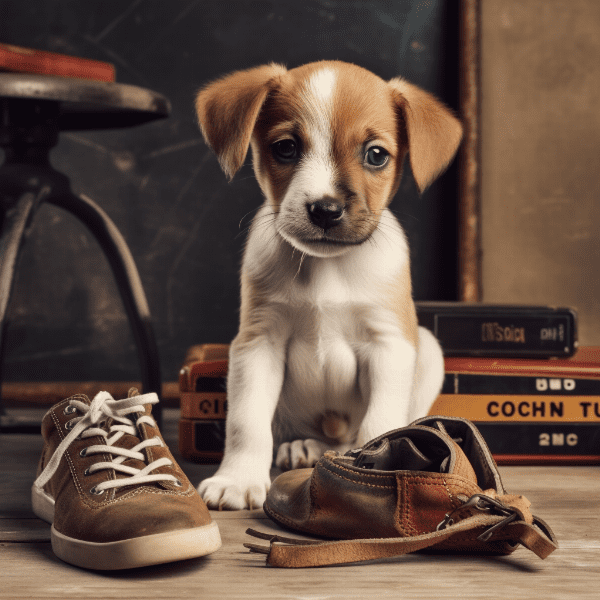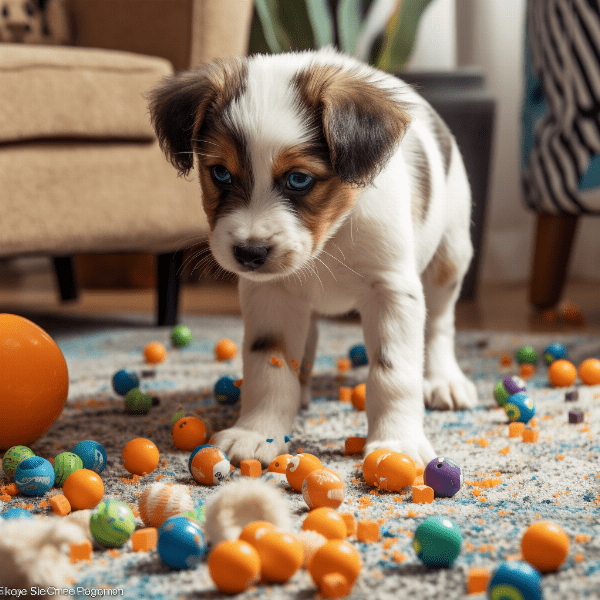Table of Contents
- Understanding the Reasons Behind Puppy Chewing
- Puppy-Proofing Your Home to Prevent Chewing
- Providing Appropriate Chewing Alternatives
- Positive Reinforcement Training to Stop Chewing
- Using Bitter Sprays or Repellents as Deterrents
- Crating Your Puppy When You’re Not Home
- Seeking Professional Help for Persistent Chewing
- Consistency and Patience: Key to Success
- Common Mistakes to Avoid When Stopping Puppy Chewing
- Maintaining a Chew-Free Home: Tips and Tricks
Understanding the Reasons Behind Puppy Chewing
Puppies are adorable, playful, and curious creatures. However, they can also be destructive, especially when it comes to chewing on furniture and other household items. Understanding why puppies chew is the first step in stopping this behavior.
It’s a Natural Instinct
Chewing is a natural instinct for dogs, especially puppies. They use their mouths to explore the world around them and relieve discomfort caused by teething. When puppies chew, they also release endorphins that make them feel good.
Boredom and Lack of Exercise
Just like humans, dogs can get bored and restless when they don’t get enough exercise or mental stimulation. Puppies that don’t get enough playtime or exercise may resort to chewing on furniture to alleviate their boredom.
Anxiety and Stress
Puppies can experience anxiety and stress just like humans. Separation anxiety, fear of loud noises, and changes in their environment can all cause stress for puppies. Chewing can be a way for puppies to cope with their anxiety and relieve stress.
Attention-Seeking Behavior
Puppies are social creatures that crave attention and affection from their owners. Chewing on furniture can be a way for puppies to get their owner’s attention, even if it’s negative attention.
Teething
Teething is a painful process that puppies go through as their baby teeth fall out and adult teeth come in. Chewing on furniture can relieve the discomfort caused by teething.
Understanding the reasons behind Puppy chewing is crucial in stopping this behavior. By addressing the root cause of your puppy’s chewing, you can implement the most effective solutions to stop it.

Puppy-Proofing Your Home to Prevent Chewing
Preventing your puppy from chewing on furniture starts with puppy-proofing your home. By making some simple adjustments to your living space, you can create a safe and chew-free environment for your furry friend.
Identify Potential Hazards
The first step in puppy-proofing your home is to identify potential hazards that your puppy may be tempted to chew on. Start by walking around your home and identifying any items that are within reach of your puppy. This includes furniture, electrical cords, and household plants.
Keep Valuables Out of Reach
Valuable items such as shoes, books, and electronics should be kept out of your puppy’s reach. Store them in a closet or on a high shelf where your puppy cannot get to them.
Block Off Restricted Areas
If there are areas of your home that you do not want your puppy to access, such as your bedroom or home office, block them off with baby gates or closed doors. This will prevent your puppy from chewing on furniture or other items in these areas.
Provide Safe Chewing Alternatives
Provide your puppy with safe chewing alternatives such as chew toys or bones. This will redirect their chewing behavior away from furniture and onto items that are safe for them to chew on.
Puppy-proofing your home is an essential step in preventing your puppy from chewing on furniture. By identifying potential hazards, keeping valuables out of reach, using taste deterrents, blocking off restricted areas, and providing safe chewing alternatives, you can create a safe and chew-free environment for your furry friend.
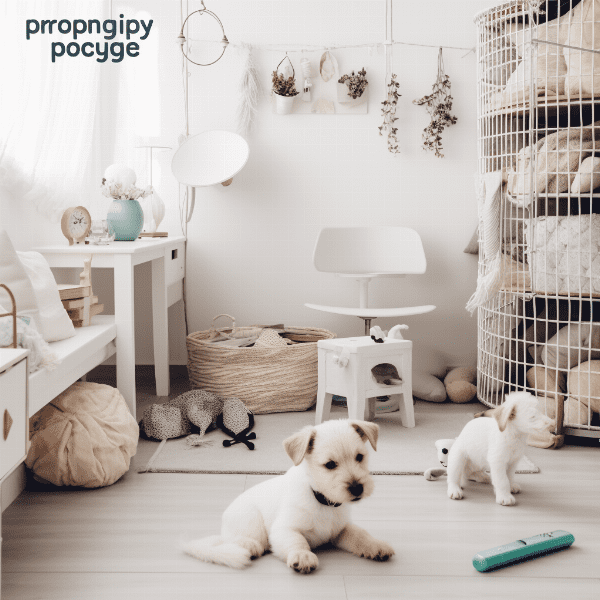
Providing Appropriate Chewing Alternatives
Puppies need to chew, so it’s important to provide them with appropriate chewing alternatives. By giving your puppy items that are safe and satisfying to chew on, you can redirect their chewing behavior away from furniture and onto items that are appropriate.
Choose Appropriate Chew Toys
When choosing chew toys for your puppy, it’s important to select ones that are appropriate for their age, breed, and size. Chew toys come in a variety of materials such as rubber, nylon, and rawhide. Make sure to choose toys that are durable and safe for your puppy to chew on.
Rotate Chew Toys
Rotating your puppy’s chew toys can help keep them interested and engaged. Introduce new toys regularly and remove toys that are worn or damaged. This will prevent your puppy from getting bored with their toys and seeking out other items to chew on.
Freeze Chew Toys
Freezing chew toys can provide additional relief for teething puppies. Soak the chew toy in water or broth and freeze it for a few hours before giving it to your puppy. The cold temperature can soothe your puppy’s sore gums and provide a satisfying chewing experience.
Offer Edible Chews
Edible chews such as rawhide or bully sticks can provide your puppy with a satisfying chewing experience. However, it’s important to supervise your puppy while they are chewing on these items to prevent choking or swallowing large pieces.
Make Chew Toys More Appealing
Make chew toys more appealing to your puppy by smearing a small amount of peanut butter or cream cheese on them. This can make them more enticing and encourage your puppy to chew on them.
Providing appropriate chewing alternatives is an important step in stopping your puppy from chewing on furniture. By choosing appropriate chew toys, rotating toys, freezing chew toys, offering edible chews, and making chew toys more appealing, you can redirect your puppy’s chewing behavior onto safe and appropriate items.
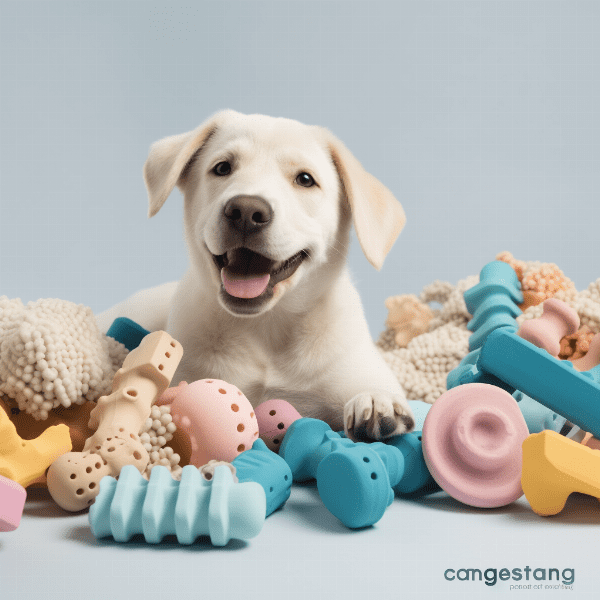
Positive Reinforcement Training to Stop Chewing
Positive reinforcement training is a highly effective method for stopping puppy chewing. By using rewards and positive reinforcement, you can teach your puppy what behaviors are acceptable and what behaviors are not.
Start Early
Start positive reinforcement training early to prevent your puppy from developing bad chewing habits. Consistency is key, so make sure to enforce the same rules every time your puppy chews on something they shouldn’t.
Redirect Bad Behavior
When you catch your puppy chewing on furniture or other items they shouldn’t, immediately redirect their behavior onto an appropriate chew toy. This will teach them what is acceptable to chew on and what is not.
Avoid Punishment
Avoid punishing your puppy for chewing on furniture, as this can create fear and anxiety. Instead, focus on positive reinforcement and redirecting their behavior onto appropriate chew toys.
.

Using Bitter Sprays or Repellents as Deterrents
Bitter sprays or repellents are a common method for deterring puppies from chewing on furniture. These sprays have a bitter taste that is unpleasant to dogs, making them less likely to chew on furniture that has been sprayed.
Choose a Safe and Effective Product
When choosing a bitter spray or repellent, it’s important to select a safe and effective product. Look for sprays that are made with natural ingredients and are safe for your puppy to ingest. Avoid sprays that contain harsh chemicals or artificial flavors.
Apply the Spray Consistently
Apply the bitter spray or repellent consistently to furniture or other items that your puppy has been chewing on. Make sure to follow the manufacturer’s instructions for application and reapplication.
Monitor Your Puppy’s Behavior
Monitor your puppy’s behavior after applying the bitter spray or repellent. Some puppies may still be tempted to chew on furniture, even with the bitter taste. If your puppy continues to chew on furniture, consider trying a different deterrent or seeking professional help.
Use in Conjunction with Positive Reinforcement
Using bitter sprays or repellents should be combined with positive reinforcement training. This will teach your puppy what behaviors are acceptable and what behaviors are not, and provide them with appropriate alternatives to chew on.
Bitter sprays or repellents can be an effective method for deterring puppies from chewing on furniture. By choosing a safe and effective product, applying it consistently, being patient, monitoring your puppy’s behavior, and using it in conjunction with positive reinforcement, you can stop your puppy from chewing on furniture and redirect their behavior onto appropriate chew toys.
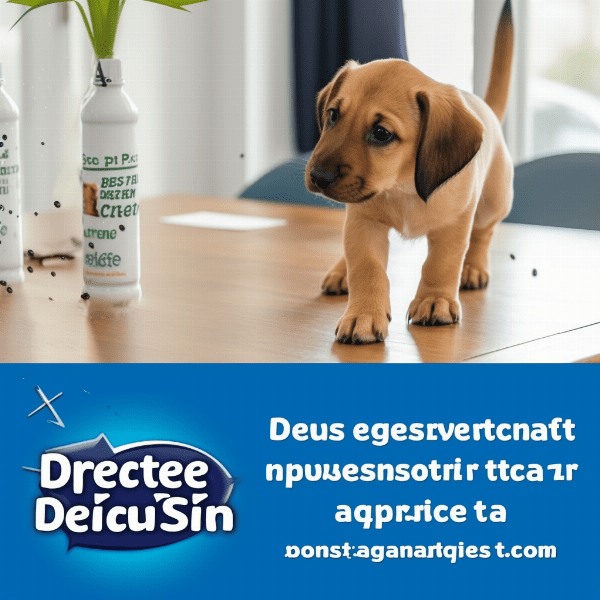
Crating Your Puppy When You’re Not Home
Crating your puppy when you’re not home can be an effective method for preventing them from chewing on furniture. A crate can provide a safe and secure environment for your puppy, and prevent them from accessing items that they shouldn’t chew on.
Choose the Right Size Crate
Choose a crate that is appropriate for your puppy’s size and breed. The crate should be large enough for your puppy to stand up, turn around, and lie down comfortably, but not so large that they have enough room to chew on items within the crate.
Make the Crate a Positive Place
Make the crate a positive place for your puppy by providing them with a comfortable bed and some toys to play with. Encourage your puppy to use the crate by offering treats and praise when they enter it.
Start Slowly
Introduce your puppy to the crate slowly, and never force them inside. Start by leaving the crate door open and placing treats inside. Gradually encourage your puppy to spend more time in the crate with the door closed.
Don’t Leave Your Puppy in the Crate Too Long
Puppies should not be left in a crate for extended periods of time. They need frequent bathroom breaks and exercise. A general rule of thumb is that puppies can hold their bladder for one hour for every month of age, up to eight hours.
Use in Conjunction with Other Methods
Crating your puppy when you’re not home should be used in conjunction with other methods such as positive reinforcement training, providing appropriate chewing alternatives, and puppy-proofing your home.
Crating your puppy when you’re not home can be an effective method for preventing them from chewing on furniture. By choosing the right size crate, making the crate a positive place, starting slowly, not leaving your puppy in the crate too long, and using it in conjunction with other methods, you can create a safe and secure environment for your puppy when you’re not home.
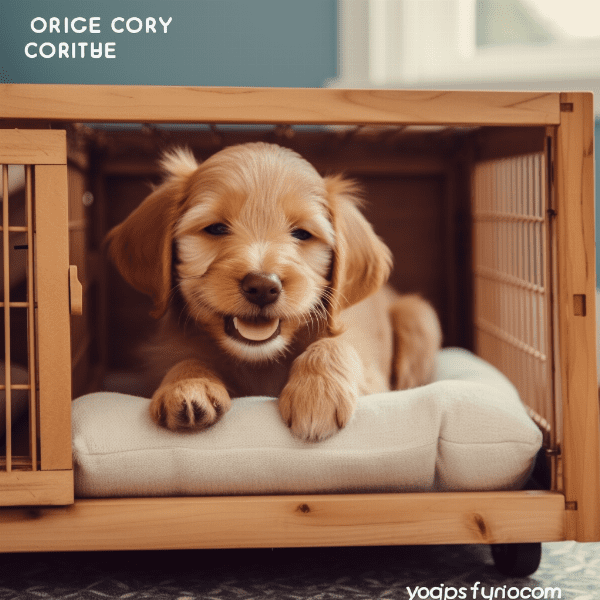
Seeking Professional Help for Persistent Chewing
If your puppy’s chewing behavior persists despite your best efforts, it may be time to seek professional help. A professional dog trainer or behaviorist can help you address the root cause of your puppy’s chewing and develop a personalized training plan to stop the behavior.
Identify the Root Cause
A professional dog trainer or behaviorist can help you identify the root cause of your puppy’s chewing behavior. They can assess your puppy’s environment, daily routine, and behavior to determine what may be causing the behavior.
Develop a Personalized Training Plan
Based on their assessment, a professional dog trainer or behaviorist can develop a personalized training plan to stop your puppy’s chewing behavior. This may involve positive reinforcement training, addressing anxiety or stress, and modifying your puppy’s environment.
Provide Professional Supervision
Professional supervision can be invaluable when trying to stop persistent chewing behavior. A dog trainer or behaviorist can provide supervision and guidance during training sessions, and offer support and advice when dealing with challenging behaviors.
Address Underlying Medical Issues
In some cases, persistent chewing behavior may be caused by underlying medical issues such as dental problems or gastrointestinal issues. A veterinarian can help identify and address any medical issues that may be contributing to your puppy’s chewing behavior.
Be Patient and Consistent
Stopping persistent chewing behavior takes time, patience, and consistency. Follow the training plan developed by the professional dog trainer or behaviorist, and be patient as you work through the behavior with your puppy.
Seeking professional help can be a valuable resource for stopping persistent chewing behavior in your puppy. By identifying the root cause, developing a personalized training plan, providing professional supervision, addressing underlying medical issues, and being patient and consistent, you can help your puppy overcome their chewing behavior and develop appropriate chewing habits.
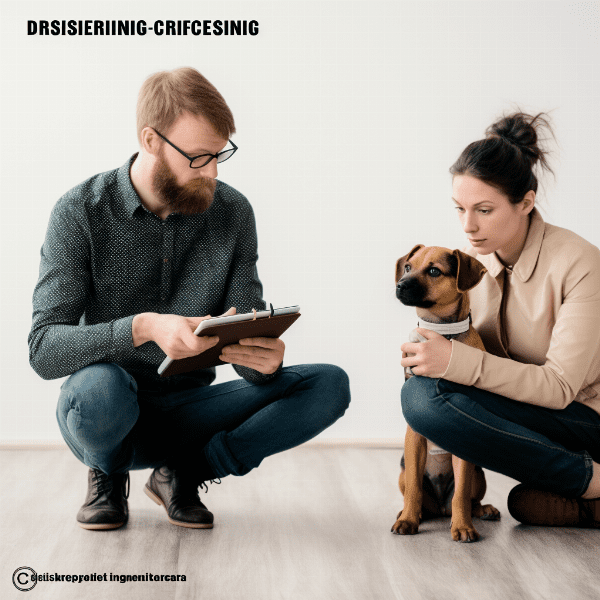
Consistency and Patience: Key to Success
Stopping your puppy from chewing on furniture requires consistency and patience. It’s important to understand that changing your puppy’s behavior takes time, and that there may be setbacks along the way. However, by remaining consistent and patient, you can achieve success.
Be Patient
Stopping your puppy’s chewing behavior takes time and patience. It’s important to remember that your puppy is still learning and may make mistakes along the way. Be patient and understanding as you work with them to develop appropriate chewing habits.
Don’t Give Up
There may be setbacks along the way, but it’s important not to give up. Consistency and patience are essential to achieving success in stopping your puppy from chewing on furniture. Keep working with your puppy and seeking professional help if needed.
Celebrate Successes
Celebrate your puppy’s successes along the way. When your puppy chews on an appropriate item, provide them with praise and treats. This will reinforce the behavior and encourage them to continue chewing on appropriate items.
Keep Learning and Growing
Continued learning and growth is essential to achieving success in stopping your puppy from chewing on furniture. Keep researching and trying new methods, and seek professional help when needed. By continuing to learn and grow, you can develop the skills and knowledge necessary to help your puppy develop appropriate chewing habits.
Consistency and patience are key to stopping your puppy from chewing on furniture. By remaining consistent, being patient, not giving up, celebrating successes, and continuing to learn and grow, you can achieve success in redirecting your puppy’s chewing behavior onto appropriate items.
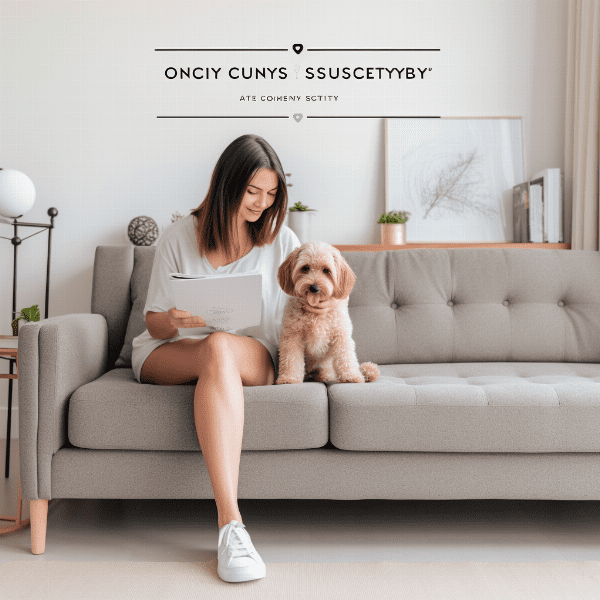
Common Mistakes to Avoid When Stopping Puppy Chewing
Stopping your puppy from chewing on furniture can be a challenging task, and there are several common mistakes that pet owners make. By avoiding these mistakes, you can improve your chances of success in redirecting your puppy’s chewing behavior onto appropriate items.
Mistake #1: Punishing Your Puppy
Punishing your puppy for chewing on furniture can create fear and anxiety, and may actually worsen their chewing behavior. Instead of punishing your puppy, focus on positive reinforcement training and providing appropriate chewing alternatives.
Mistake #2: Not Providing Enough Chewing Alternatives
Not providing enough chewing alternatives can lead to boredom and frustration, which may cause your puppy to seek out inappropriate items to chew on. Make sure to provide a variety of safe and appropriate chew toys for your puppy to play with.
Mistake #3: Inconsistency in Training
Inconsistency in training can confuse your puppy and make it difficult for them to learn appropriate chewing habits. Make sure to enforce the same rules every time your puppy chews on something they shouldn’t, and provide consistent positive reinforcement when they chew on appropriate items.
Mistake #4: Using Inappropriate Chew Toys
Using inappropriate chew toys, such as toys that are too small or made of unsafe materials, can put your puppy at risk of choking or injury. Make sure to choose chew toys that are appropriate for your puppy’s size and breed, and are made with safe materials.
Mistake #5: Failing to Supervise Your Puppy
Failing to supervise your puppy can lead to destructive chewing behavior. Make sure to keep a close eye on your puppy and intervene when necessary to redirect their behavior onto appropriate chew toys.
Mistake #6: Not Seeking Professional Help When Needed
By avoiding these common mistakes, you can improve your chances of success in stopping your puppy from chewing on furniture. Focus on positive reinforcement training, provide enough appropriate chew toys, be consistent in your training, use safe and appropriate chew toys, supervise your puppy, and seek professional help when needed.
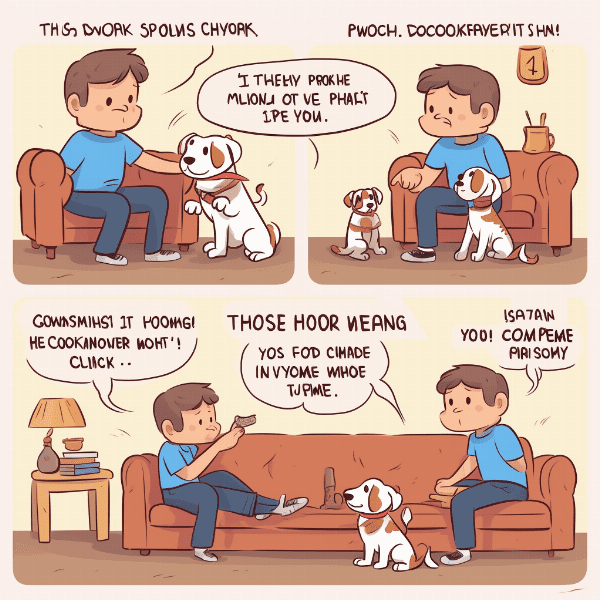
Maintaining a Chew-Free Home: Tips and Tricks
Maintaining a chew-free home requires a combination of prevention, training, and supervision. By following these tips and tricks, you can help ensure that your puppy develops appropriate chewing habits and that your home stays free from damage.
Prevention
Prevention is key to maintaining a chew-free home. Puppy-proof your home by removing any items that your puppy may be tempted to chew on, and keep them in areas that are off-limits to your puppy. Use baby gates or barriers to keep your puppy in safe areas of the house.
Positive Reinforcement Training
Positive reinforcement training can help teach your puppy what items are appropriate to chew on and what items are not. Use praise and treats to reinforce appropriate chewing behavior, and redirect your puppy’s behavior onto appropriate chew toys when they chew on inappropriate items.
Supervision
Supervision is essential when it comes to maintaining a chew-free home. Keep a close eye on your puppy when they are out of their crate, and intervene if they begin to chew on inappropriate items.
Provide Appropriate Chew Toys
Provide a variety of safe and appropriate chew toys for your puppy to play with. This will help prevent boredom and frustration, which can lead to destructive chewing behavior.
Use Bitter Sprays or Repellents
Bitter sprays or repellents can be an effective deterrent for preventing your puppy from chewing on furniture. Follow the manufacturer’s instructions for application, and reapply as needed.
Seek Professional Help When Needed
By following these tips and tricks, you can help maintain a chew-free home and ensure that your puppy develops appropriate chewing habits. Prevent destructive chewing behavior by puppy-proofing your home, use positive reinforcement training, supervise your puppy, provide appropriate chew toys, use bitter sprays or repellents, and seek professional help when needed.
